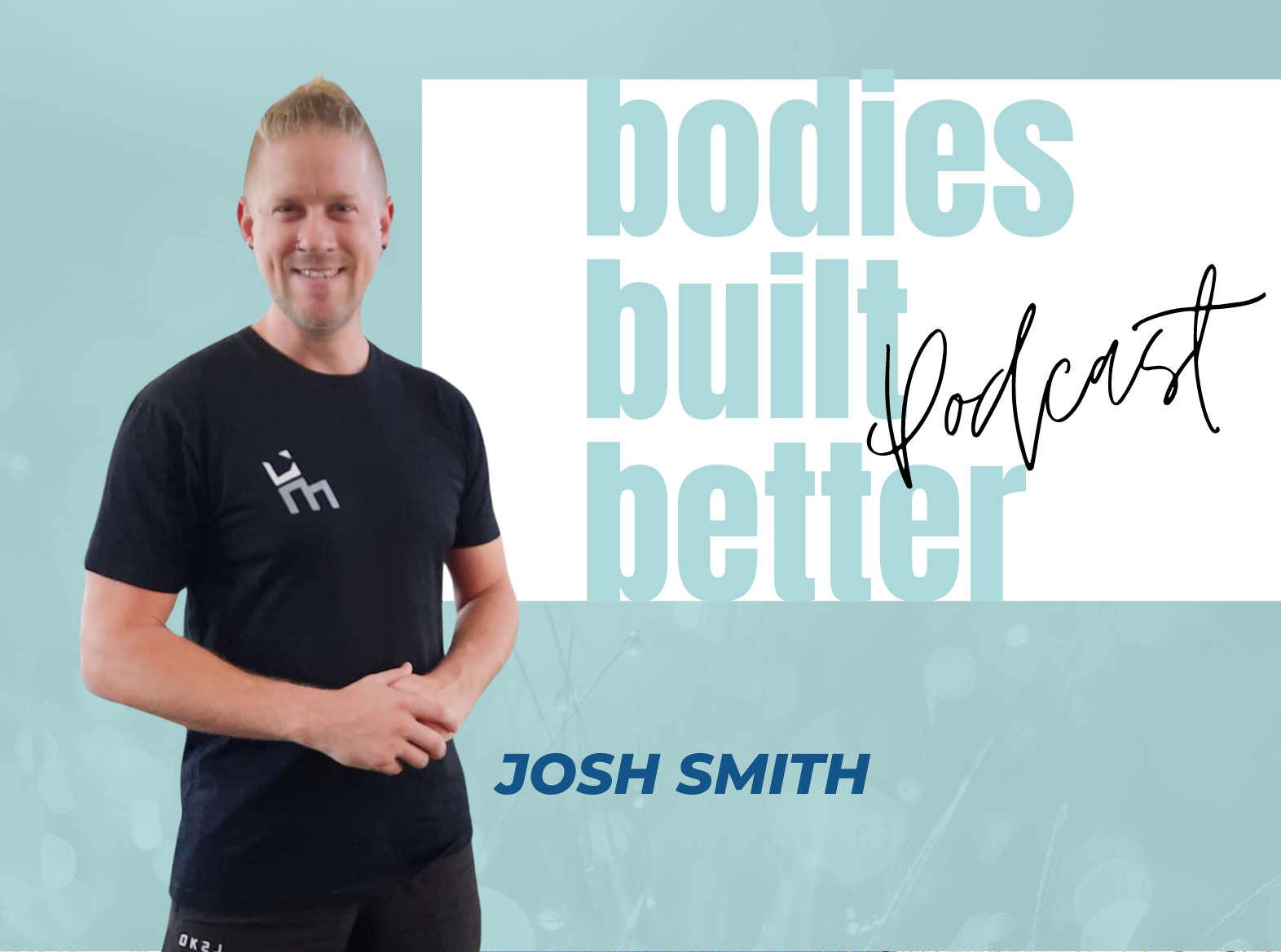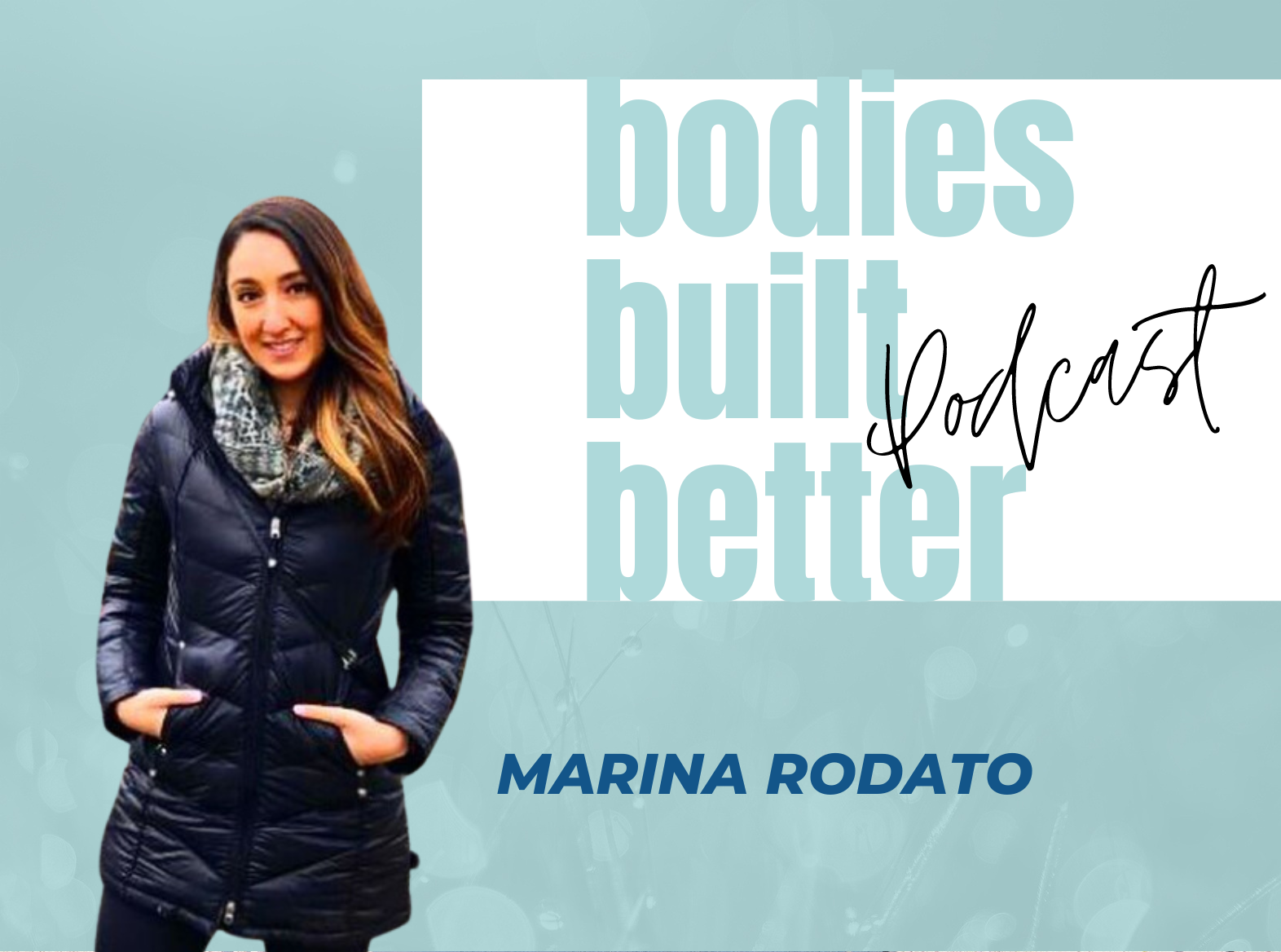The Truth About Pelvic Floor Health: What You Need to Know
Jackie 2:00
This is Dr. Jessica Warnecke on pelvic floor Health. Dr. Jessica, thank you so much for chatting with me today. Welcome to the Bodies Built Better podcast.
Jessica 2:10
Hi, Jackie, thank you so much for having me. I’m so excited for this discussion.
Jackie 2:15
Yeah, me too. While we’re talking all about pelvic floor health. And I feel like it’s one of those things that people only really think about it if they’re in a Pilates class, or if all they think–they don’t need to be thinking about it unless they’re pregnant, which is completely not the case. And I’m excited to talk more about that today with you. But before we get into that, I’d love for you to talk more about yourself and let listeners know about how you got into physical therapy. And why pelvic floor health?
Jessica 2:50
Yes, thank you. So I’ve been primarily an orthopedic physical therapist. So I went into PT, just loving sports, loving to stay active. I was you know, in probably every sport that you can imagine from a kid on up. So I was used to just moving my body and of course getting injured having to go to my own PT. And so when I first entered, I was like, okay, let’s let’s dive into the orthopaedic–the sports world. Let’s help active people, you know, overcome injuries, recover from surgeries, all that fun stuff. And then a few years into my career, I had to take more CEE use. So like continuing education courses, and things like that. And I was like, there’s an area of the body that nobody ever really talks about, we honestly don’t discuss it much in school, is the pelvic floor and I’m like, maybe I’ll just take one course for the pelvic floor because I don’t really know much about it. And I have to take a course anyways. So long story short, I got into my first course, which was, like, very intimidating, but by the end of it, I was like, Oh my gosh, I am so in love with this topic. The information, the education, the techniques we learned in the course were so valuable for every single body type, male, female, whether they’re active, or sedentary moms are not like I was amazed how much I learned that could literally apply to anybody. And so that kind of just got me into the world of like, okay, I need to learn more. And so I’ve now taken you know, years of pelvic floor courses, I’ve–it’s one of the specialties I now offer in my clinic, and it’s just such a rewarding area to be able to treat especially with women because I just feel like it’s not–it’s getting talked about more but it’s still an area and a conversation that a lot of people don’t know about much about especially other health care professionals like I will talk to females that are nurses or you know, nutritionist or things like that. And they, they deal with women all the time. But they’re like, wait, what exactly do you do with the pelvic floor? Like, what is the pelvic floor? So it’s like, wow, okay. Even just in health care, like, we still don’t know as much as we should. And so it’s just been a really fascinating journey to go into, over the last few years and kind of use the information for myself personally, but see how much it can transform the lives of so many people that I interact with. And it’s been just a very fulfilling piece of the journey that I’ve been on. So I love it.
The Missing Piece to the Puzzle: Why Pelvic Floor Health Matters
Jackie 5:31
Yeah, that’s amazing. And I find it so interesting that, you know, it’s, it’s not, you’re not diving deep into that threat that you’re, you know, your studies. And yet, it’s such an important part of anatomy and health.
Jessica 5:48
Absolutely. Well, and even at the beginning, before I started, you know, marketing and really treating much of pelvic floor clients, I was like, oh, this is helping my client with chronic low back pain or frequent hip injuries with right like all of these things where they would get better, but then either the injury would come back, or there was still a missing link that we couldn’t figure out. And I was like, ah, this is the extra piece of the puzzle that this person has been searching for. And it’s just been such a game changer.
Jackie 6:19
Yeah, absolutely. And it’s funny you say that, because I’ve seen clients come through, just like you said, with the low back pain with the recurring hip injuries, and discover later on that it is to do with the pelvic floor. And so yeah, such a huge thing. I’m so excited to talk more about this. So we, we alluded to the fact that it’s not just for women and for women who are pregnant, So let’s give a I guess a generalised talk about what the pelvic floor is, and why it does affect everyone.
Jessica 6:58
Yes, great starting point. So the pelvic floor is like the deepest layer of our core, it’s a huge component of our core. And essentially, it’s made up of a group of muscles that sit within the pelvis. And these muscles function for a lot of different reasons. It helps with bowel and bladder movements, it helps with just the stability and the strength of the hips, the core and the legs need. It also helps with circulation between the lower body and the upper body. And it helps with sexual function and cohesively, it’s just something that whether you have, you know, a male anatomy or female anatomy, the muscles are pretty similar. And the functions are pretty similar. But typically, we see, or we talk more about women with pelvic floor dysfunctions, because so much of it is internal and so much of it, we can’t just see, like with day to day stuff, and with easy things. And so a lot of women tend not to be as aware of their pelvic floor muscles, and what all they are helping or not contributing to. And so it’s kind of a new area of just exploration for a lot of people. But it’s definitely a very important component for everybody to be aware of, just because of the role it plays with bowel and bladder stability. You know, if you’re an athlete, or if you’re doing regular exercise, and you’re doing core work, you have to include the pelvic floor. And or you have to know how to feel it in order to make sure you’re truly getting a well rounded workout or programme or whatever it is that you’re doing.
Pelvic Floor Dysfunction: The Unspoken Issue
Jackie 8:31
Okay, and then so what does it mean when we have a pelvic floor dysfunction?
Jessica 8:39
Yeah, so that’s a broad term to essentially describe that the pelvic floor muscles can’t correctly contract and relax. So whether it’s a weakness or a tightness, or a coordination, limitation, or a combination of all of it, there’s something going on, to where the muscles just aren’t doing exactly what they’re supposed to do. And it leads to limitations with urination, or bowel movements, or pain with intercourse, or weakness with exercise, or a number of things like that.
Jackie 9:09
Yeah. Okay. So how, how does this happen? Like, what are the causes that lead to all of these things that could happen?
Jessica 9:20
Oh, my gosh, that’s, well, we can talk for an hour just in general, I think part of it, you know, especially for somebody that’s, you know, let’s talk about people that haven’t had a baby. And so they think, okay, my pelvic floor should be fine. It should be healthy. But think of a muscle that you have in your body that’s active with everything but you’ve never done anything for like you’re not aware of it, you’re not you don’t strengthen it, you don’t stretch it, you don’t do anything. Eventually, the rest of the muscles around it are going to be compensating because that muscle isn’t doing its role. And so sometimes it’s just not being aware of it and so it’s not naturally utilized in, you know, exercise or daily activities the way it should be, oftentimes to for women that are heavy into strength training, or even certain types of like Pilates or still built like bar those types of workouts, a lot of times, they’re just not correctly activating their core. And so they’re maybe, like, putting, like incorrect pressure not enough–like not good breathing or not adequate pressure distribution, so that their pelvic floor gets tight or weak that way. And then obviously, if somebody has had a baby, whether they have a C-section, or a vaginal delivery, the pelvic floor is going through a lot of changes, and is affected both during the pregnancy and during the labor delivery and the postpartum period. And so a lot of it just comes from not having a good awareness and knowing what to do. So then something happens, and you then have to react to it, rather than being aware of it being proactive, and then, you know, preventing things in that manner. So there’s so many other, you know, ways that it can be affected. But that’s like a very general common
The Pelvic Floor and Sports: How They Impact Each Other
Jackie 11:11
Yeah, okay. Well, let’s, let’s get a little bit specific now, in terms of the pelvic floor and sports for the athletes out there. How is the pelvic floor influenced or impacted, by sport? And I understand it depends on what they’re doing. But let’s get a brief overview. And then we’ll dive deeper into some different sports.
Jessica 11:34
Yeah, great question. So if we’re thinking about just, you know, the body moving actively, everything has to work together, right, our body is all connected. So if there’s a limitation in one part of the chain, something else down, the link is going to be involved, right. And so I think this is where the awareness of the pelvic floor is important because you have to make sure that the pelvic floor is supporting the hip and supporting the back and the knees, the feet, they’re all working with the pelvis and the trunk. And so oftentimes, whether you were you know, perfect with our trading or not, usually there’s a little bit of a discrepancy between one side and the other side, or with certain, like, planes of movement, you know, going up and down is different than going side to side. And so oftentimes, just having a little compensation or a little bit of a weakness, or maybe even a little bit of a stiffness in the hip, over the course of time, will travel to other parts of the body. And then eventually, you know, lead to either a bigger thing, if they have an injury, or just something that becomes a little bit more chronic. And maybe it just starts out, nagging. And you know, oh, I can brush this off to the side. But then over the course of months or years, they’ve–they keep doing the repetitive movements without solving that root cause. And so now the body’s like, hey, I need you to listen to me. So I’m going to have more pain, or I’m going to have bigger limitations with what you’re trying to do, because I need you to address this whole foundation. And so yeah, oftentimes, it’s like, okay, well, if you’re running, you know, playing a sport with a ball, and you have to chase it around in some predictable, if your pelvic floor isn’t supporting the rest of your core and the hip, and then gradually over the course of time, things are just kind of wearing down a little bit.
How to Strengthen Your Pelvic Floor for Better Hip Health
Jackie 13:21
Yes, how do we know that–that could be the problem, or that could be the issue. If say, our hip is getting sore from, you know, field sport or something? How could we then bring it back to the pelvic floor? Is it something that we can feel?
Jessica 13:39
So usually, it kind of matches up with some other symptoms, right? So if we–so sometimes let’s take it purely orthopedic. And let’s say you have a nagging hip injury, and you go to PT, and maybe it gets better, but then you go back to do the sport again, and then your injury comes back, or is kind of like a roller coaster, or maybe certain things bother it, and you’re like, okay, I’ve figured out how to do these things, but then new things start bothering it. So it’s like, okay, there’s still something missing, that cues us into, okay, we haven’t truly identified the full root cause we have to look a little deeper, or we have to look above the hip or we have to look below the hip. And often if you’re, if you haven’t yet seen a physical therapist or physiotherapist, and they like, typically we’ll look at the back of the knees or things around the hip. And if that’s still not enough to solve the problem, then you know, okay, there’s something else that’s go a little deeper. Other scenarios is if there’s pain with other types of things, such as using the restroom, wearing a tampon, having intercourse leaking, whether you’ve had a baby or not leaking is never normal. And so those are all signs that the pelvic floor is involved in some way.
Jackie 14:53
Okay, and when you say leaking, is this for both male and female, or is it–
Jessica 14:59
Yep, Yep, I can happen on both.
How Triathlon Disciplines Affect Pelvic Floor and Well-Being
Jackie 15:02
Okay. Alright, let’s, let’s dive into let’s start with running. And I guess that maybe the triathlete. I’ve got a few triathletes who listen. How–how does a triathlon or other disciplines of a triathlon affect the pelvic floor and someone’s well-being?
Jessica 15:23
Yes. So this is great working with any type of endurance athletes, they–their muscles, oh my gosh, they’re just, they’re awesome, right, they can do so many things. And so one of my biggest things when working with endurance athletes is making sure that they’re doing enough relaxation-type exercises, to complement all the load that their body is taking. And so what I mean by that briefly is things like breathing. Certain types of positional hip and low back postures can help isolate the pelvic floor a little bit better. And then also keeping in mind how they’re feeling when they’re doing each of their sports. So when you’re running, you’re standing up, well, how do you feel standing and running compared to sitting for a long time, because if there’s a certain limitation or discomfort with a positional change that also can cue us into, okay, well, this might be because your hip is in this position, therefore, your pelvic floor is shortened here. And so that’s what’s causing that. So those types of things can cue us into, okay, how much of it is going to be impacting just because you’re in that position, or how much of it is a global pelvic floor or functional thing that’s going to affect all like the swimming, the running, and the cycling, just because of how much load and volume you’re doing. So always want to make sure that they’re adequately getting good relaxation, and good lengthening types of exercises into their warm-ups, into their cooldowns into their recovery days. And then from a strength standpoint, every triathlete, every runner, every endurance athlete should be doing something for strength. And if they can be doing unilateral movement, so meaning one side of the body is working, separate from the other side, that’s really important, as well as working all planes of movement. So you’re working side to side, you’re working your rotation, you’re working up and down. That way the body in the trunk is loaded in all planes of movement, which it needs to do. If it’s running, if it’s swimming, like our body is constantly twisting and turning. And so just making sure that their training programmes are set up for that helps enhance pelvic floor function and just helps the longevity of what they’re able to do.
Connect with Jess:
Website: www.pacept.com
Instagram: @drjessicapt
Resources: https://www.pacept.com/pelvicfloorinfo.html
If you enjoyed this episode of The Bodies Built Better Podcast please hit SUBSCRIBE and share it with your friends.
Head over to The bodes built better podcast page – https://jackietann.com/the-bodies-built-better-podcast/
Follow @jackietann_rmt and @bodiesbuiltbetter on Instagram
Got questions, comments, or feedback? Get in touch via the above social media handles.







